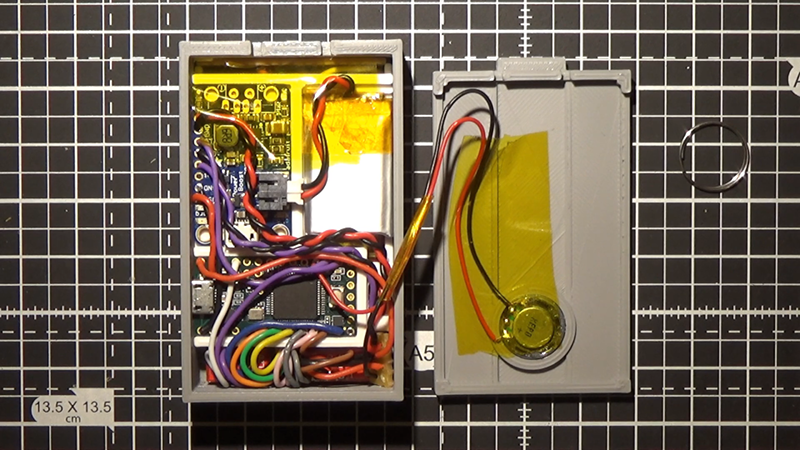There’s a lot of debate over which of several contenders was the first modern computer. One of those first operating computers was the University of Cambridge’s EDSAC — the brainchild of Dr. Maurice Wilkes. The EDSAC scored a lot of firsts and used a serial data path along with mercury delay line memories. Over on Hackaday.io, [David Boucher] wanted to simulate the EDSAC in a much smaller form factor than the original room full of racks.
As you can see in the video below, he succeeded in that task, using a Teensy and a small LCD display. We’re reminded EDSAC was among the first machines so some of the terms we would employ were not in use yet. An order is an instruction, for example. Initial orders are akin to a bootloader.
You think of computer sounds as a modern thing, but the EDSAC had a speaker connected to the sign bit of the accumulator and operators could hear programs in operation. With time, they could recognize certain things about a program’s execution based upon the sound.
You can see some vintage 1949 programs running deliberately slowed down because the new hardware can run much faster than the original. We are guessing there’s no mercury in the replica, neither did he original machine have a 3D printed case.
If you want to know more about EDSAC, there is a wealth of information out there and we’ve covered it before. If you don’t want to build, you can run EDSAC in your browser.
















Imagine the EPA might have had an issue if mercury had been used. Maybe he could have simulated with some old bubble memory?
The EDSAC rebuild team ran into exactly that problem in building their full scape replica. Their solution was to use nickel delay lines instead. There is a series of videos about their project starting here: https://www.youtube.com/watch?v=C97MtJWDNX8
The patent on mercury delay lines was held by Alan Turing, who suggested an alternative liquid that could be used instead in mercury: gin!
I’ll drink to that.
First stored-programmable digital computer = Baby… The Manchester Computer.
+1
The Manchester Baby ran its first program on 21 June 1948, whereas the EDSAC ran its first programs on 6 May 1949.
The Manchester Baby used Williams–Kilburn tube (based on a standard CRT) as its random-access digital storage device.
This is why I say “one of the first” in the video: to avoid this sort of argument (and Al’s summary above does the same to be fair to him). “First computer” depends on which definition of “computer” you use.
But you are correct in that the Manchester Baby was operational before EDSAC.
> IS THAT A VINTAGE COMPUTER IN YOUR POCKET?
No, as clearly stated in the article.
> ARE YOU SIMULATING AN EDSAC IN YOUR POCKET?
first programmable computer was built by Konrad Zuse
https://en.m.wikipedia.org/wiki/Z3_(computer)
This.
Cool to see an EDSAC replica. The display for this system was quite odd: the CRT was meant to just be a RAM monitor, showing a page of RAM so you could see the inner state of the machine. Clever programmers soon learned to use it as a bitmap display page instead and run Tic-Tac-Toe or similar in it.
The EDSAC has 18-bit ints, but (if I remember right) the topmost bit in the actual system was quite flaky, so programs would use only 17 bits instead!
The machine had a 36-bit full word, but one bit was needed for housekeeping. It provided short words, half of the full word, and you can’t have half-bits, so they made it two 17-bit integers with a spare bit in the middle, known as the ‘Sandwich bit’.
The vintage computer might be an old one and does not have the modified parts but it was much easier to use as it did not have so many features and complications which does not rise to some other problems.
Congratulations David. I am working on the EDSAC rebuild at The National Museum of Computing, and you have created a truly brilliant little replica. I wonder if the shop at TNMOC might consider selling kits of this to visitors – I’m sure it will sell well.
We are just having a conversation between EDSAC project members on the very clever programming that Wilkes and Wheeler used in the Primes routine to save an order of magnitude of instructions in the “divide by subtraction” code – EDSAC didn’t have a divide instruction.
Tony
EDSAC Volunteer
Well done David. I think every member of the EDSAC Replica team should be issued with one. The other missing word in the various descriptions of EDSAC was “general purpose” which differentiates it from earlier computers. The Z3 had no jump instruction and had no read/write memory that could be used for program and/or data.
This is looking very awesome David.
The old computer may be outdated and lack modern parts, but it was much simpler to use because it lacked complicated functions that could cause other issues.
Yes, technology has evolved too fast but i still miss miss those old age tech as they were very easy to use.
still miss those old day vintage computers.